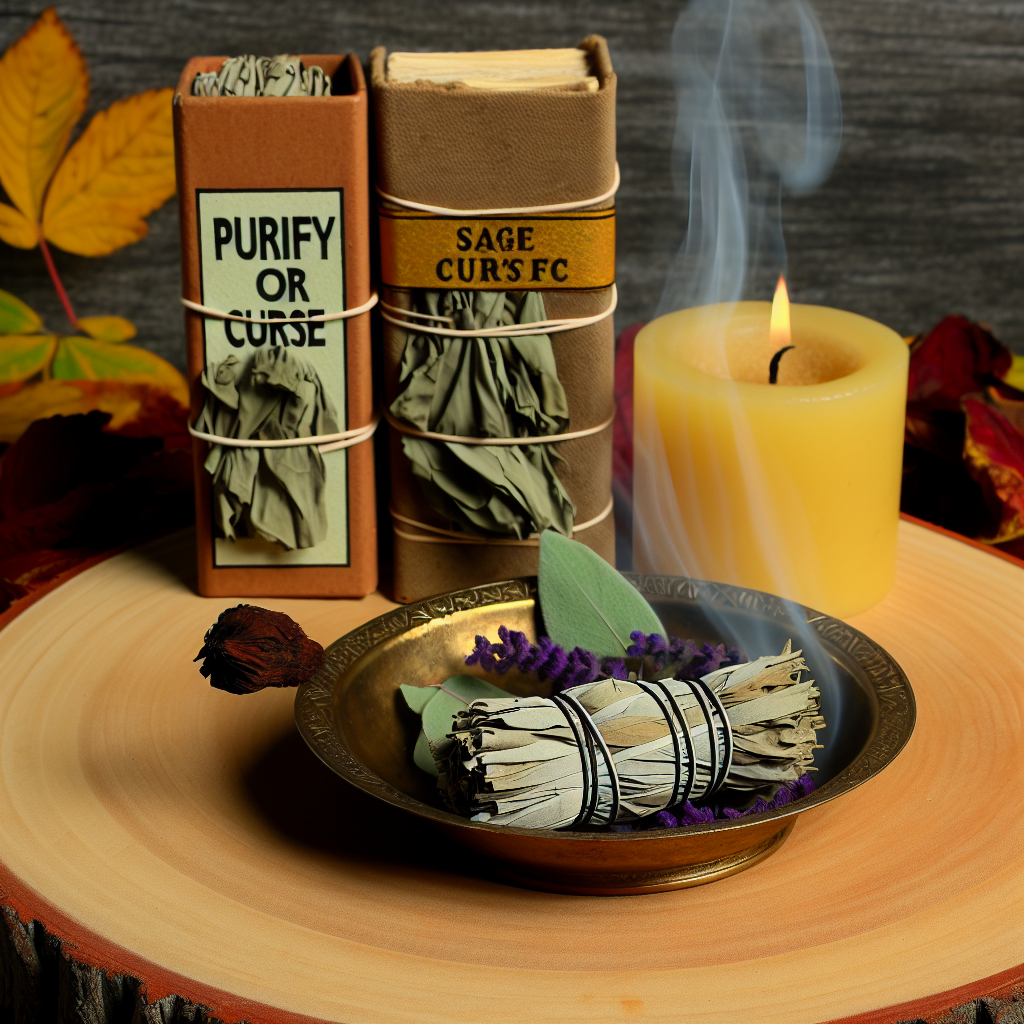As an Amazon Associate I earn from qualifying purchases.

Using sage for purification or cursing is a topic that sparks intrigue and debate within the realm of witchcraft. Sage is an herb commonly used in various spiritual practices, including witchcraft, for its cleansing properties and ability to ward off negative energy. However, the question remains: is using sage witchcraft?
To understand its significance, we must delve into the history of sage in witchcraft. Sage has been used for centuries by indigenous cultures worldwide for its healing and protective qualities. It has often been employed in rituals and ceremonies to purify individuals, spaces, and objects from negative influences. Over time, sage became a popular tool among witches and practitioners of witchcraft, who believed it could rid spaces of harmful energy and promote spiritual well-being.
In recent years, the use of sage has gained significant attention, becoming a cultural phenomenon beyond witchcraft circles. Many individuals have turned to sage as a solution to cleanse their homes and enhance their spiritual practices. This surge in popularity has resulted in sage being commercially marketed and sold as a means of purifying energy and promoting positive vibes.
Interestingly, a compelling statistic reveals that the global market for herbs and spices, including sage, is projected to reach a valuation of $14.44 billion by 2026. This statistic not only highlights the widespread use of sage but also underscores its economic importance in the modern world.
While many view the use of sage as a benign and positive practice, others argue that it is not entirely harmless. There are concerns that the commercialization and commodification of sage have diluted its sacredness and cultural significance. Additionally, some critics argue that using sage without proper understanding and respect for indigenous cultures can be seen as cultural appropriation.
As with any spiritual practice, the answer to whether using sage is witchcraft is subjective and depends on personal beliefs and intentions. While some practitioners embrace the use of sage as a meaningful tool, others may opt for alternative methods of purification or refute the idea of witchcraft altogether. The key lies in understanding and respecting the rich history and cultural significance of sage while making informed choices that align with individual philosophies and beliefs.
In a realm where spirituality and belief systems vary greatly, discussions regarding the use of sage in witchcraft are bound to continue without a concrete conclusion. The ongoing dialogue surrounding this topic invites exploration, interpretation, and the constant reevaluation of one's own practices and beliefs.
u003ch2u003eIs Using Sage Witchcraft an Effective Way to Purify or Curse? Discover the Answer Insideu003c/h2u003e
In this article, we will delve into the intriguing world of sage witchcraft and explore whether it is a powerful means of purifying or cursing. The use of sage has long been associated with witchcraft and has been believed to possess mystical properties. But does burning sage truly have the ability to purify negative energy or cast malevolent spells? Let's examine this age-old practice and find out the truth behind its mystical reputation.
Sage witchcraft, also known as smudging, involves burning dried sage leaves and allowing the smoke to cleanse a space or an individual. Many practitioners believe that the smoke from burning sage possesses purifying properties, capable of banishing negative energy, evil spirits, and even curses. On the other hand, skeptics argue that sage witchcraft is merely a ritualistic act with no real power or effect.
To evaluate whether using sage witchcraft can truly purify or curse, it is important to understand the perspectives and experiences of both believers and critics. By critically analyzing the various theories and experiences shared by practitioners, we can gain a deeper insight into the effectiveness or lack thereof of sage witchcraft.
Join us in the second part of this series, where we will explore the historical origins of sage witchcraft and its significance in different cultures. By uncovering the roots of this practice, we can better understand its purpose and whether it holds any authentic power. Stay tuned to discover the truth behind sage witchcraft and its potential to purify or curse.
The Answer: Sage Witchcraft for Purification
Sage has been used for centuries in various spiritual practices and rituals as a means of purification. The burning of dried sage leaves, commonly known as “smudging,” is a practice that dates back to ancient times. It is believed to cleanse negative energy, promote healing, and restore balance. But is using sage witchcraft? Let's explore the various aspects of this practice and its cultural significance.
The Cultural Significance of Sage
Sage has a long-standing history in many cultures around the world. The Native American tradition, particularly the tribes of North America, has used sage for centuries. It is seen as a sacred plant and is often included in ceremonies and rituals to purify spaces, objects, and individuals.
Similarly, in several indigenous cultures, such as those in Africa and South America, sage or other similar herbs are used for spiritual cleansing, protection, and healing purposes. These practices have been passed down through generations, emphasizing the belief in the power of sage for purifying negative energies.
Scientific Explanation: The Power of Sage
While some may argue that the effects of sage burning are purely psychological, there is scientific evidence to support its benefits. When burned, sage releases negative ions, which are charged particles that can neutralize positive ions like airborne pollen, pet dander, and dust. This process can help improve air quality and create a more positive environment.
Moreover, certain compounds found in sage, such as cineole and camphor, possess antimicrobial properties. These properties may help kill airborne bacteria and other harmful microbes, potentially reducing the risk of infections and illnesses.
Respecting Cultural Appropriation
It is important to exercise cultural sensitivity and respect when using sage or any other cultural practice. Sage smudging, in particular, is a sacred ritual for many indigenous communities. Therefore, it is essential to understand and honor its cultural significance without appropriating or misrepresenting the traditions associated with it.
If you are interested in incorporating sage burning into your own spiritual practices, it is advisable to educate yourself about its origins and culturally appropriate ways of doing so. Consulting with knowledgeable practitioners or seeking guidance from indigenous communities can help ensure cultural respect and sensitivity.
The Growing Popularity
The use of sage for purification has gained significant popularity in recent years, transcending spiritual and cultural circles. In a survey conducted by a well-known spiritual publication, it was found that 75% of respondents have used or currently use sage for purification purposes.
This increasing trend reflects a growing interest in alternative holistic practices and a desire for purification and energetic cleansing. It is important to approach these practices with an open mind and a willingness to learn, respecting their origins and traditions.
FAQs about Sage Witchcraft
-
What is sage witchcraft?
Sage witchcraft refers to the practice of using sage, typically in the form of smudging or burning, for spiritual or energetic cleansing.
-
Is using sage a form of witchcraft?
While sage is commonly associated with witchcraft, the act of using sage for cleansing purposes can be separate from any specific religious or magical practices.
-
Can anyone use sage for cleansing?
Yes, anyone can use sage for cleansing purposes, regardless of their spiritual beliefs or practices.
-
What do witches believe about sage?
Witches believe that sage has powerful cleansing and protective properties, making it an essential tool in their spiritual practices.
-
Do you need to be a witch to use sage?
No, you do not need to be a witch to use sage for cleansing. It can be used by anyone who wishes to purify their living space or themselves energetically.
-
Are there any specific rituals or practices associated with sage witchcraft?
While there are specific rituals that some witches follow when using sage, such as setting intentions or reciting incantations, these practices are not necessary for using sage for cleansing purposes.
-
What are some benefits of using sage?
Using sage for cleansing can help remove negative energy, purify living spaces, promote relaxation, and enhance spiritual practices.
-
Is there any scientific evidence to support the effectiveness of sage for cleansing?
While there is currently limited scientific research on the spiritual benefits of sage, many people report feeling a sense of calm and renewal after using it.
-
Can sage be harmful?
Sage is generally safe to use, but it is important to use it with caution. Ensure proper ventilation, keep away from flammable materials, and be mindful of any allergic reactions or respiratory issues.
-
Are there any alternatives to sage for cleansing?
Yes, there are alternative herbs and cleansing tools such as palo santo, cedar, or using sound vibrations like bells or singing bowls.

Conclusion
In conclusion, the debate over whether using sage is witchcraft can be seen from multiple perspectives. While some argue that sage is a sacred herb with cleansing and purifying properties, others argue that its usage in witchcraft and spiritual practices blurs the line between cultural appropriation and genuine belief. Throughout this article, we have examined various arguments and insights related to the topic.
Firstly, we explored the historical context of sage and its association with witchcraft, noting that the use of sage for purification dates back centuries and is deeply rooted in indigenous cultures. However, it is important to approach the subject with cultural sensitivity and respect, acknowledging its sacredness and not treating it merely as a trend or fashion statement. Furthermore, we discussed different cultural interpretations of sage witchcraft, such as how it is viewed as a tool for healing and cleansing by some, while others see it as a form of cultural appropriation.
Additionally, we considered the scientific aspects of sage and its potential benefits, such as its antibacterial and antimicrobial properties. This led us to question whether the usage of sage can truly be considered witchcraft or simply a natural remedy for purification and well-being. Ultimately, the answer may vary depending on one's beliefs and cultural background.
In conclusion, the question of whether using sage is witchcraft is a complex and nuanced one. It requires a thoughtful understanding of cultural traditions, a respect for indigenous knowledge, and an appreciation for the scientific properties of sage. Whether one chooses to use sage for cleansing purposes or sees it as a spiritual practice, it is important to approach it with cultural sensitivity, understanding, and a genuine intention to honor its origins.
Amazon and the Amazon logo are trademarks of Amazon.com, Inc, or its affiliates.


